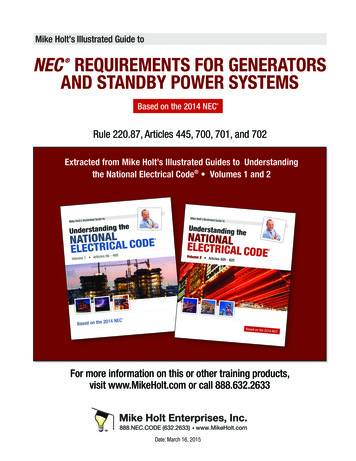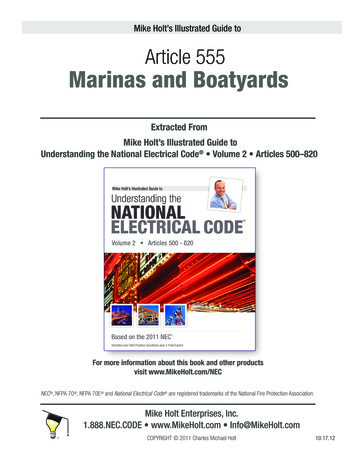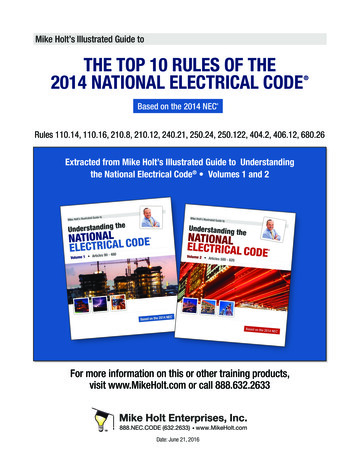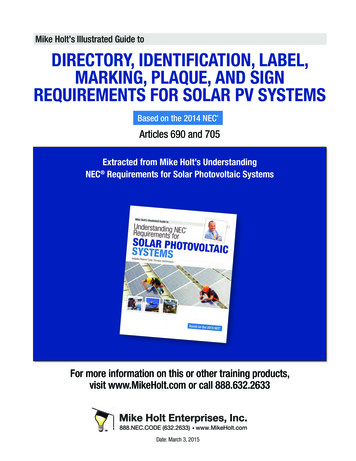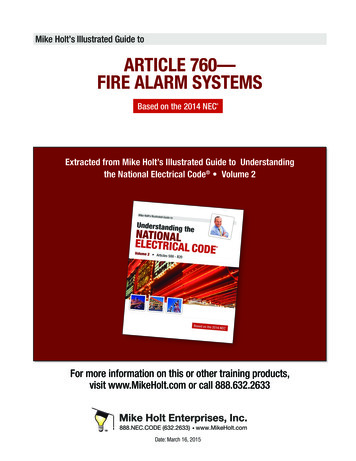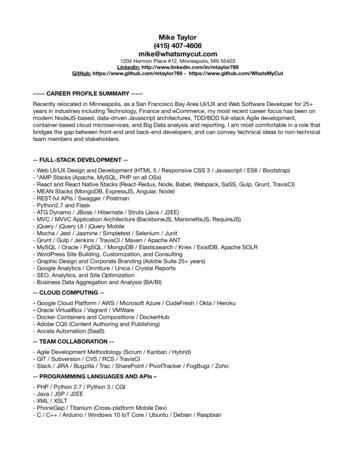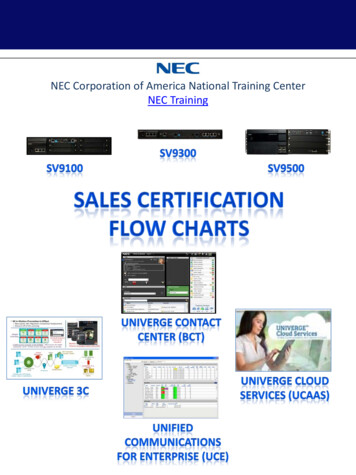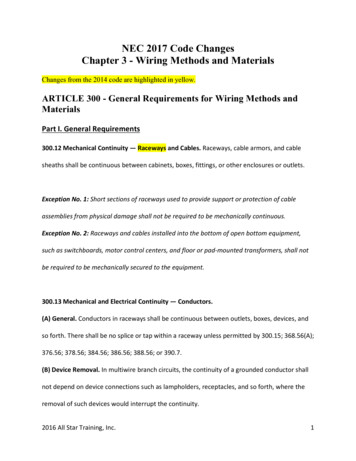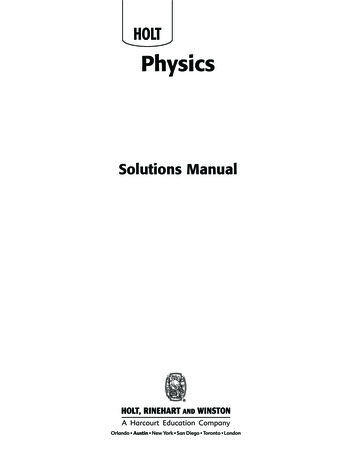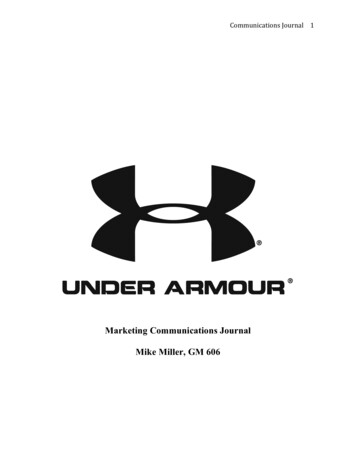
Transcription
2017NEC INDEX NEC , NFPA 70 , NFPA 70E and National Electrical Code are registered trademarks of the National Fire Protection Association.Updated: November 9, 2018
NOTICE TO THE READERThe publisher does not warrant or guarantee any of theproducts described herein or perform any independentanalysis in connection with any of the product informationcontained herein. The publisher does not assume, andexpressly disclaims, any obligation to obtain and includeinformation other than that provided to it by the manufacturer.The reader is expressly warned to consider and adopt allsafety precautions that might be indicated by the activitiesherein and to avoid all potential hazards. By following theinstructions contained herein, the reader willingly assumesall risks in connection with such instructions.The publisher makes no representation or warranties ofany kind, including but not limited to, the warranties of fitness for particular purpose or merchantability, nor are anysuch representations implied with respect to the materialset forth herein, and the publisher takes no responsibilitywith respect to such material. The publisher shall not beliable for any special, consequential, or exemplary damages resulting, in whole or part, from the reader’s use of,or reliance upon, this material.Author: Mike HoltTechnical Illustrator: Mike CulbreathCOPYRIGHT 2017 Charles Michael HoltProduced and Printed in the USAAll rights reserved. No part of this work covered by thecopyright hereon may be reproduced or used in any form orby any means graphic, electronic, or mechanical, includingphotocopying, recording, taping, or information storageand retrieval systems without the written permission ofthe publisher. You can request permission to use materialfrom this text by either calling 888.632.2633, e-mailingInfo@MikeHolt.com, or visiting www.MikeHolt.com.For more information, call 888.NEC.CODE (632.2633), ore-mail Info@MikeHolt.com.NEC , NFPA 70 , NFPA 70E and National ElectricalCode are registered trademarks of the National FireProtection Association.This logo is a registered trademark of MikeHolt Enterprises, Inc.ABOUT THE AUTHORMike Holt worked his way up throughthe electrical trade. He began as anapprentice electrician and becameone of the most recognized expertsin the world as it relates to electrical power installations. He’sworked as a journeyman electrician, master electrician, andelectrical contractor. Mike’sexperience in the real worldgives him a unique understanding of how the NECrelates to electrical installationsfrom a practical standpoint.You’ll find his writing style to bedirect, nontechnical, and powerful.Did you know Mike didn’t finish high school? Soif you struggled in high school or didn’t finish at all,don’t let it get you down. However, realizing that success depends on one’s continuing pursuit of education,Mike immediately attained his GED, and ultimatelyattended the University of Miami’s Graduate School fora Master’s degree in Business Administration.Mike resides in Central Florida, is the father of sevenchildren, has five grandchildren, and enjoys many outside interests and activities. He’s a nine-time NationalBarefoot Water-Ski Champion (1988, 1999, 2005–2009, 2012–2013). He’s set many national recordsand continues to train year-round at a World competition level (www.barefootwaterskier.com).What sets him apart from some is his commitmentto living a balanced lifestyle; placing God first, family,career, then self.I dedicate this book to theLord Jesus Christ,my mentor and teacher.Proverbs 16:3
MIKE HOLT’S2017 NEC INDEXIntroduction2017 TabsThis index is a free resource from Mike Holt Enterprises. It wasdesigned to help you find what you’re looking for in the Code book inseconds! This index lists difficult key words and gives you the sectionwhere these words appear in the National Electrical Code . It’s a greattool to get you familiar with those hard to find references in the NEC .Use this index along with your Code book and tabs (below) and you’llbe in great shape!Peel-and-stick Tabs are a great way tocustom ize your Code book, but too manytabs defeat the purpose. Mike Holt’sadhesive tabs allow you to mark andreference important articles and tablesquickly, making it easier for you to use theNEC. They are compatible with the 2017Code Book and Handbook, and can evenbe used on Mike's Holt's Understandingthe National Electrical Code Volumes 1 and 2 which have color-codedchapters to match the colors of the tabs.2017 Code BookNeed to order a Code book? Choose from thesoftbound, the spiral or the loose leaf version. Themost widely adopted element of a building codein the United States and the world, the NEC isthe bench mark for safe and efficient electricalinstallations. Whether your jurisdiction adoptsthe 2017 Code immediately or down the road,you need to extend your knowledge and take advantage of the benefits right away, not months or years behind your peers in the electricalindustry.Included in the set are 96 tabs, including 7 blank ones, a 16 in. x 20 in.Raceway and Wire Sizing Poster, and 2 Ohms Wheel Stickers.Order at www.MikeHolt.com/Code or call 888.632.2633.Call our office at 888.632.2633 or visit www.MikeHolt.com/Code toorder your copy.For more on this and other products, visit www.mikeholt.com/Code.Mike Holt Enterprises www.MikeHolt.com 888.NEC.CODE (632.2633)iii
NotesivFREE PDF—Mike Holt's 2017 NEC Index
PART###HOW TO USE THE NATIONALELECTRICAL CODEThe original NEC document was developed in 1897 as a result of the united efforts of various insurance, electrical, architectural, and other allied interests. The National Fire Protection Association (NFPA) has sponsored the National ElectricalCode since 1911.The purpose of the Code is the practical safeguarding of persons and property from hazards arising from the use of electricity. It isn’t intended as a design specification or an instruction manual for untrained persons. It is, in fact, a standard thatcontains the minimum requirements for electrical installations. Learning to understand and use the Code is critical to youworking safely, whether you’re training to become an electrician, or are already an electrician, electrical contractor, inspector, engineer, designer, or instructor.The NEC was written for those who understand electrical terms, theory, safety procedures, and electrical trade practices.Learning to use the Code is a lengthy process and can be frustrating if you don’t approach it the right way. First of all, you’llneed to understand electrical theory and if you don’t have theory as a background when you get into the NEC, you’re goingto be struggling—so take one step back if you need to, and learn electrical theory. You must also understand the concepts and terms, and know grammar and punctuation in order to understand the complex structure of the rules and theirintended purpose(s). Our goal for the next few pages is to give you some guidelines and suggestions on using your Codebook to help you understand what you’re trying to accomplish, and how to get there.Language Considerations for the NECTerms and ConceptsThe NEC contains many technical terms, so it’s crucial for Code usersto understand their meanings and applications. If you don’t understand a term used in a rule, it will be impossible to properly apply theNEC requirement. Article 100 defines the terms that are used in twoor more Code articles; for example, the term “Dwelling Unit” is foundin many articles. If you don’t know the NEC definition for a “dwellingunit” you can’t properly identify the Code requirements for it.Many articles have terms unique to that specific article, and the definitions of those terms are only applicable to that given article. Thesedefinitions are usually found in the beginning of the article. For example, Section 250.2 contains the definitions of terms that only apply toArticle 250—Grounding and Bonding.Small Words, Grammar, and PunctuationIt’s not only the technical words that require close attention sincesimple words can make a big difference to the application of a rule.Was there a comma; was it “or,” “and,” “other than,” “greater than,” or“smaller than”? The word “or” can imply alternate choices for wiringmethods. A word like “or” gives us choices while the word “and” canmean an additional requirement must be met.An example of these words being used in the NEC is found in110.26(C)(2), where it says equipment containing overcurrent, switching, “or” control devices that are 1,200A or more “and” over 6 ft widethat require a means of egress at each end of the working space. Inthis section, the word “or” clarifies that equipment containing any ofthe three types of devices listed must follow this rule. The word “and”clarifies that 110.26(C)(2) only applies if the equipment is both 1,200Aor more and over 6 ft wide.Mike Holt Enterprises www.MikeHolt.com 888.NEC.CODE (632.2633)1
How to Use the National Electrical CodeGrammar and punctuation play an important role in establishing themeaning of a rule. The location of a comma can dramatically changethe requirement of a rule such as in 250.28(A), where it says a mainbonding jumper must be a wire, bus, screw, or similar suitable conductor. If the comma between “bus” and “screw” was removed, onlya “bus screw” could be used. That comma makes a big change in therequirements of the rule.1. Table of Contents. The Table of Contents displays the layout ofthe chapters, articles, and parts as well as the page numbers. It’s anexcellent resource and should be referred to periodically to observethe interrelationship of the various NEC components. When attempting to locate the rules for a particular situation, knowledgeable Codeusers often go first to the Table of Contents to quickly find the specificNEC rule that applies.Slang Terms or Technical Jargon2. Chapters. There are nine chapters, each of which is divided into articles. The articles fall into one of four groupings: General Requirements(Chapters 1 through 4), Specific Requirements (Chapters 5 through 7),Communications Systems (Chapter 8), and Tables (Chapter 9).Trade-related professionals in different areas of the country often uselocal “slang” terms that aren’t shared by all. This can make it difficultto communicate if it isn’t clear what the meaning of those slang termsare. Use the proper terms by finding out what their definitions andapplications are before you use them. For example, the term “pigtail”is often used to describe the short piece of conductor used to connecta device to a splice, but a “pigtail” is also a term used for a rubberizedlight socket with pre-terminated conductors. Although the term is thesame, the meaning is very different and could cause confusion.NEC Style and LayoutIt’s important to understand the structure and writing style of theCode if you want to use it effectively. The National Electrical Code isorganized using eleven major components.1. Table of Contents2. Chapters—Chapters 1 through 9 (major categories)3. Articles—Chapter subdivisions that cover specific subjects4. Parts—Divisions used to organize article subject matter5. Sections—Divisions used to further organize article subject matter6. Tables and Figures—Represent the mandatory requirementsof a rule7. Exceptions—Alternatives to the main Code rule8. Informational Notes—explanatory material for a specific rule(not a requirement)9. Tables—Applicable as referenced in the NEC10. Annexes—Additional explanatory information such as tablesand references (not a requirement)11. Index2FREE PDF—Mike Holt's 2017 NEC IndexChapter 1—GeneralChapter 2—Wiring and ProtectionChapter 3—Wiring Methods and MaterialsChapter 4—Equipment for General UseChapter 5—Special OccupanciesChapter 6—Special EquipmentChapter 7—Special ConditionsChapter 8— Communications Systems (Telephone, Data, Satellite,Cable TV, and Broadband)Chapter 9—Tables–Conductor and Raceway Specifications3. Articles. The NEC contains approximately 140 articles, each ofwhich covers a specific subject. It begins with Article 90, the introduction to the Code, and contains the purpose of the NEC, what’s coveredand what isn’t covered, along with how the Code is arranged. It alsogives information on enforcement and how mandatory and permissive rules are written and how explanatory material is included. Article90 also includes information on formal interpretations, examination ofequipment for safety, wiring planning, and information about formatting units of measurement. Here are some other examples of articlesyou’ll find in the NEC:Article 110—Requirements for Electrical InstallationsArticle 250—Grounding and BondingArticle 300— General Requirements for Wiring Methods andMaterialsArticle 430—Motors and Motor ControllersArticle 500—Hazardous (Classified) LocationsArticle 680—Swimming Pools, Fountains, and Similar InstallationsArticle 725— Remote-Control, Signaling, and Power-LimitedCircuitsArticle 800—Communications Circuits
How to Use the National Electrical Code4. Parts. Larger articles are subdivided into parts. Because the partsof a Code article aren’t included in the section numbers, we have atendency to forget what “part” an NEC rule is relating to. For example, Table 110.34(A) contains working space clearances for electricalequipment. If we aren’t careful, we might think this table applies to allelectrical installations, but Table 110.34(A) is located in Part III, whichonly contains requirements for “Over 1,000 Volts, Nominal” installations. The rules for working clearances for electrical equipment forsystems 1,000V, nominal, or less are contained in Table 110.26(A)(1),which is located in Part II—1,000 Volts, Nominal, or Less.5. Sections. Each NEC rule is called a “Code Section.” A Code section may be broken down into subsections by letters in parentheseslike (A), numbers in parentheses like (1), and lowercase letters like(a), (b), and so on, to further break the rule down to the second andthird level. For exampl
09.11.2018 · NEC. They are compatible with the 2017 Code Book and Handbook, and can even be used on Mike's Holt's Understanding the National Electrical Code Volumes 1 and 2 which have color-coded chapters to match the colors of the tabs. Included in the set are 96
